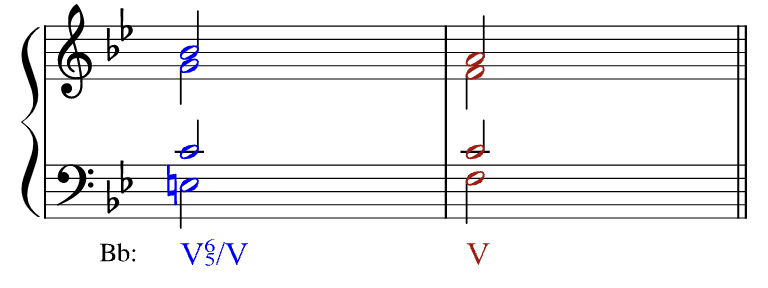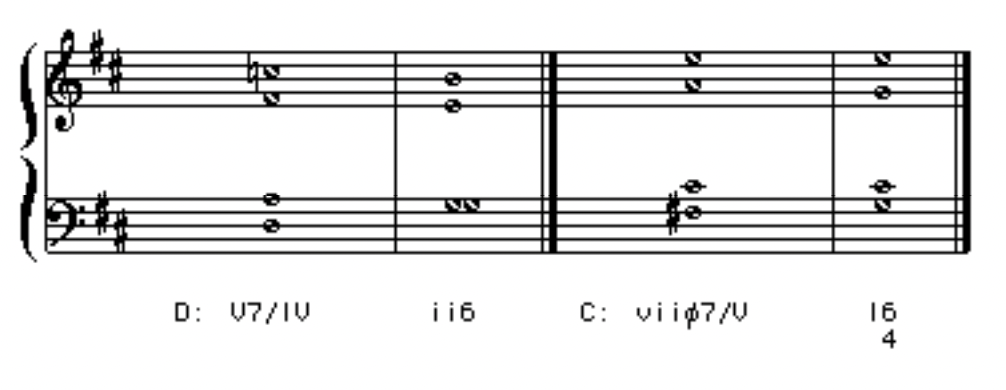7.2 Part Writing of Secondary Dominant Chords
6 min read•june 18, 2024
Sumi Vora
AP Music Theory 🎶
72 resourcesSee Units
Last section, we reviewed secondary dominants in depth. Here, we will give voice leading rules to write secondary dominants. First, let’s review what tonicization and secondary dominants are:
Tonicization and Secondary Dominants
Tonicization is a really brief modulation of keys, where you just borrow a few notes from another key. The key that you are borrowing notes from is usually called the secondary key, and the tonic of the secondary key is called the temporary tonic.
For example, in a piece of music in the key of C major, the tonicization of the key of G major would involve the use of chords and progressions that are characteristic of G major, such as the use of the G major chord, or the progression I-V-vi-IV, before resolving back to the C major chord.
The best way to identify tonicizations is to look for accidentals from closely related keys in a passage. This is especially true if you notice an accidental (that is not the leading tone in minor) resolving upward by step. This is called a leading tone relationship, and it is likely that this note is resolving to a temporary tonic note.
Now that you know the tonic of the secondary key, you can figure out which chord led into the temporary tonic. Most likely, this chord will have a dominant function, so it will either be a V chord or a vii chord in the secondary key.
You can only tonicize major or minor triads–not diminished or augmented triads. That means that in a major key, vii° cannot be tonicized, and in a minor key, ii° cannot be tonicized. In written music, it is easy to identify tonicization when there are accidentals.
It is most common to tonicize to the dominant, the subdominant, or the supertonic (V, IV, ii) of the primary key. For example, in A major, the secondary key would be the dominant–E major–so the secondary dominant would be the dominant of E major–B major. So, if you're looking at a piece in A major and you see II chords popping up, then you may want to consider the idea that you are looking at a tonicization.
Secondary Dominants
The reason why we usually have the chord leading into the temporary tonic as a dominant chord is that we want listeners to hear the temporary tonic as a tonic. Since the leading tone in dominant chords have a strong tendency to resolve to the tonic, the leading tone in these “temporary” dominant chords have a strong tendency to resolve to the temporary tonic.
These temporary dominant chords have a special name: secondary dominants.
The most common secondary dominant is the V/V, which is the dominant of the dominant chord. For example, in the key of C major, the dominant chord is G major, and the V/V is D major. By using the D major chord, the music temporarily tonicizes the key of G major before resolving back to C major.
Secondary dominants can also tonicize chords other than the dominant. For example, in the key of C major, the V/ii tonicization, which uses the A Major chord followed by the D minor chord, temporarily tonicizes the D minor chord. We can also have the secondary dominant of the subdominant, which would be a V/IV chord, and it would resolve to the IV chord.
Notice that in C Major, the V/IV chord resolving to the IV chord won’t have extra accidentals, so it would be hard to tell if this is a I-IV progression or a V/IV-IV progression. Usually, though, it will be apparent from context if there is a temporary tonicization. This might include adding accidentals, specifically a Bb in C Major, in non-chord tones or surrounding chords, or it might involve using the subdominant tone more frequently surrounding the chord progression.
Secondary dominants are usually used around cadences. Secondary dominants can also be extended to create longer chains of tonicization, known as "cadential extension." This can involve the use of multiple secondary dominants in succession, creating a sense of tension and release as the music temporarily tonicizes multiple keys before resolving back to the main key.
Cadential extension usually involves either adding suffixes or prefixes to the cadence, although developing the dominant and tonic sections of a cadence is also possible. Suffixes are harmonic extensions of the cadence after resolving to the dominant section, and usually involve tonicizing chords other than the dominant in order to prolong the section after a phrase. For example, you can have a V-I cadence, followed by a V/ii-ii cadence, and so on. These suffixes can either eventually resolve back to the home key, as in an ascending fourths harmonic sequence, or they can signal modulation to a new key. Note that it is always the case that these tonicizations will involve chromaticizations in order to ensure that the secondary dominant is a Major triad or Major-minor seventh chord.
Prefixes, on the other hand, also have the same properties has suffixes in terms of the chromaticizations and the ascending fourths sequence, but these prefixes end with a cadence in the home key, since they are appearing before the final cadence. For example, a ii-V/IV-IV-V-I cadential extension is common. Notice that if we wrote this is a ii-I-IV-V-I cadence, we obfuscate the fact that the I chord is acting as a secondary dominant for the IV chord, and it looks strange that a ii is voice leading to a I chord. This is why contextual analysis is important.
Part Writing Secondary Dominants
When part writing secondary dominants, we should always use the same voice leading rules as when writing a V-I cadence. Specifically, we should always resolve the “leading tone,” i.e. the third of the secondary dominant chord, up by step.
Usually, secondary dominant chords will be written in 1st inversion so that the #4 is on the bottom. A IV-V⁶₅/V-V progression is common because it establishes the bassline 4-#4-5, and a chromatic bassline sounds cool. Additionally, if you see the #4-5 progression, then you can assume that it is a V/V-V progression of some sort.
When we voice lead from a complete V chord or a complete V7 chord in the secondary key, it is okay to write an incomplete I chord in the secondary key if this works better in the overall harmonic progression. This is only true, though, if the I chord in the secondary key is in root position. In this case, we will usually triple the root of the chord, and only have one instance of the third of the chord, so as to prevent parallel thirds or fifths.
We can write perfect authentic cadences in secondary keys, or we can write some other type of cadence in the secondary key. We want to make sure that it is a cadence because we want the listener to “hear” the tonic of the primary key as a temporary tonic. However, we can have strong cadences or weaker cadences to fulfill this need.
Regular, Irregular, and Deceptive Resolution
When a secondary dominant, e.g. V/V, resolves to the tonic chord of the secondary key, e.g. V/V-V progressions, we call this regular resolution.
If we write a perfect authentic cadence in the secondary key, then we want the new tonic to sound very strong. This strategy is often used when modulating to a new key. Remember: here are the rules for writing perfect authentic cadences:
- It must use a V chord as the dominant chord (as opposed to a vii or viio chord) ✅
- Both chords must be in root position. ✅
- The soprano voice must end on the tonic. ✅
- The soprano must move by step. ✅
Notice that if we are to follow these rules, then we must write the leading tone of the secondary key in the soprano voice.
We can also write imperfect authentic cadences using secondary dominants – for example, if one of the chords is not in root position. We don’t usually write plagal cadences, e.g. IV/V-V when using tonicizations.
Here is an example of regular resolution:

Image via Open Music Theory
Irregular resolution occurs when we move to a substitute of the tonic chord of the primary key. An example is a V/IV-ii6 progression, or a vii/V-I6/4 progression. These are effective because a ii6 chord, especially where the third is doubled, is a substitute for the subdominant IV chord, and similarly, the I 6/4 chord often acts as a substitute for the dominant V chord.
Here are examples of these progressions:

Finally, deceptive resolution would involve moving from the V of the secondary key to the sixth of a secondary key. An example would be a V6/5/V moving to a iii chord.
🦜 Polly wants a progress tracker: Look at this exam question from the 2018 AP Music Theory FRQ section. Can you resolve the secondary dominant properly?
Browse Study Guides By Unit
🎵Unit 1 – Music Fundamentals I (Pitch, Major Scales and Key Signatures, Rhythm, Meter, and Expressive Elements)
🎶Unit 2 – Music Fundamentals II (Minor Scales and Key Signatures, Melody, Timbre, and Texture)
🎻Unit 3 – Music Fundamentals III (Triads and Seventh Chords)
🎹Unit 4 – Harmony and Voice Leading I (Chord Function, Cadence, and Phrase)
🎸Unit 5: Harmony and Voice Leading II: Chord Progressions and Predominant Function
🎺Unit 6 – Harmony and Voice Leading III (Embellishments, Motives, and Melodic Devices)
🎤Unit 7 – Harmony and Voice Leading IV (Secondary Function)
🎷Unit 8 – Modes & Form
🧐Exam Skills
📚Study Tools

Fiveable
Resources
© 2025 Fiveable Inc. All rights reserved.